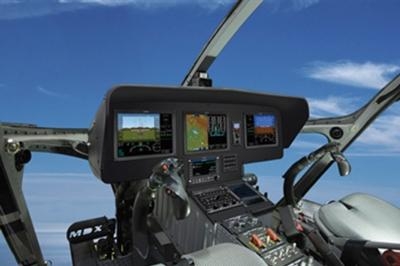Thu, Oct 16, 2014
Program Developments Include Availability Of Fully Functional And Interactive Demonstration Simulator
The Next Generation flight deck for the MD Explorer program has reached what the companies call important milestones.

At the MDHI Mesa facility, final vendor selections for all peripheral avionics systems have been completed and documentation for installation and approval, as well as preliminary systems safety assessments, are in work. System requirements reviews are also ongoing. Of particular note, the engineering prototype helicopter that will be the conforming article for FAA ground and flight test is undergoing a major overhaul / rework to meet the latest designs and standards.
“The Universal Avionics Next Generation flight deck development for the MD Explorer helicopter is advancing as expected,” said Grady Dees, Universal Avionics’ Director of Technical Sales. “Universal Avionics is currently working on finalizing specifications for Engine and CAS development as well as design and construction on the systems integration test rig that will be used for both integrated testing and for demonstration / Human Factors evaluations,” he added.
“This collaboration with Universal Avionics is a reinforcement of MDHI’s commitment to advancing our brand and evolving our product in accordance with the MDHI legacy of advancement through innovation and the infusion of technology-based capabilities,” said Bill James, MD Helicopters’ Chief Technology Officer. “Our joint development with Universal of this Next Generation flight deck is sure to make this already iconic helicopter – known for its proprietary NOTAR technology and superior mission performance – the premier light-twin in our space.”
The Next Generation single-pilot IFR-capable flight deck is available through MDHI for production and retrofit of any MD Explorer helicopter. It is designed to ensure the MD Explorer maintains its position as the most capable, cost-effective and versatile light-twin helicopter available. Specifically tailored for the low altitude operations of rotorcraft, the new flight deck features large format high-resolution LCD displays with LED backlighting. A collective-mounted Cursor Slew Switch allows for a unique “point and click” display control allowing pilots to keep “hands on, head up” during all phases of flight for unprecedented situational awareness..
(Image provided by Universal Avionics)
More News
Aero Linx: Transport Canada We are a federal institution, leading the Transport Canada portfolio and working with our partners. Transport Canada is responsible for transportation p>[...]
Gross Navigation Error (GNE) A lateral deviation from a cleared track, normally in excess of 25 Nautical Miles (NM). More stringent standards (for example, 10NM in some parts of th>[...]
From AirVenture 2017 (YouTube Edition): Flight-Proven Booster On Display At AirVenture… EAA AirVenture Oshkosh is known primarily as a celebration of experimental and amateu>[...]
Aircraft Parachute System (CAPS) Was Deployed About 293 Ft Above Ground Level, Which Was Too Low To Allow For Full Deployment Of The Parachute System Analysis: The day before the a>[...]
Also: 48th Annual Air Race Classic, Hot Air Balloon Fire, FAA v Banning 100LL, Complete Remote Pilot The news Piper PA-18 Super Cub owners have been waiting for has finally arrived>[...]
 ANN's Daily Aero-Linx (06.29.25)
ANN's Daily Aero-Linx (06.29.25) ANN's Daily Aero-Term (06.29.25): Gross Navigation Error (GNE)
ANN's Daily Aero-Term (06.29.25): Gross Navigation Error (GNE) Classic Aero-TV: Anticipating Futurespace - Blue Origin Visits Airventure 2017
Classic Aero-TV: Anticipating Futurespace - Blue Origin Visits Airventure 2017 NTSB Final Report: Cirrus SR22
NTSB Final Report: Cirrus SR22 Airborne Affordable Flyers 06.26.25: PA18 Upgrades, Delta Force, Rhinebeck
Airborne Affordable Flyers 06.26.25: PA18 Upgrades, Delta Force, Rhinebeck



